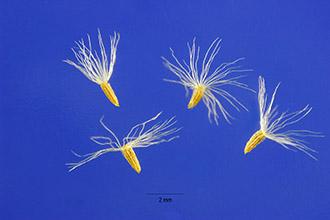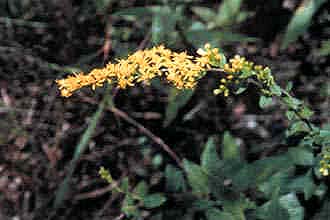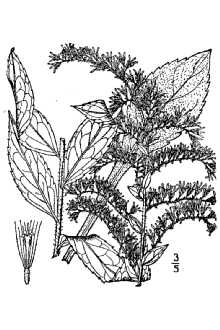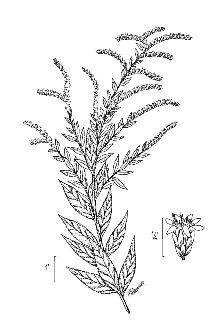Wrinkleleaf Goldenrod
Scientific Name: Solidago rugosa Mill.

| General Information | |
|---|---|
| Usda Symbol | SORU2 |
| Group | Dicot |
| Life Cycle | Perennial |
| Growth Habits | Forb/herb |
| Native Locations | SORU2 |
Plant Guide
Description
General: Wrinkleleaf goldenrod is a native, herbaceous perennial wildflower that generally grows 2–6.5 feet tall, occasionally reaching up to 8 feet in height (Hawke, 2000). This species clones through creeping rhizomes, and forms clumps of up to fifty stems from a single stem (Flora of North America, 2020). Stems are densely bristled or strigose, though are occasionally found hairless. Leaves grow alternately, reaching up to 4 inches long and 1 inch wide. The largest leaves are found mid-stem and gradually decrease in size as they approach the inflorescence. Leaves are lanceolate, elliptic, or ovate in shape with serrated or toothed edges, tapering into a point. Leaf blades can be thin and glabrous, or thick, rough, and wrinkled in texture. Nerves may be prominent, especially on the underside of the leaf, appearing sunken above. Pinnate veins on the leaf surface cause a wrinkled texture. Small, yellow flowers, or rays, grow on panicles that reach 0.5–14.5 inches in length, or even longer in cultivars. These flowers bloom as early as September and begin to seed in early November. The seeds are small and cone-shaped, with pappus hairs on the wide end (USDA-ARS, 2020) for wind dispersal. Including the pappus hairs, the seed length is no more than 0.1 inch (Flora of North America, 2020) and difficult to see with the naked eye. Wrinkleleaf goldenrod has highly variable physical characteristics. This species is divided into two subspecies. The more common subspecies, S. rugosa ssp. rugosa, has three separate varieties. This wide variability makes varieties difficult to identify. Wrinkleleaf goldenrod can be confused with other goldenrod species, such as elmleaf goldenrod (S. ulmifolia) and roundleaf goldenrod (S. patula). This species hybridizes with other closely related goldenrod species, such bog goldenrod (Solidago uliginosa). Wrinkleleaf goldenrod is distinguished by examining the hairiness of the stem, as other species are minimally hairy or lack hair (Hilty, 2018). More common species, such as Canada goldenrod (Solidago canadensis), is distinguished by the presence of three distinct parallel veins on the leaf surface. Distribution: Wrinkleleaf goldenrod occurs throughout the eastern region of the United States in hardiness zones 4b–8b. This range extends into Eastern Canada, as far as Newfoundland. The range extends as far west as Michigan, Missouri, Southeastern Oklahoma, and Northeastern Texas (Taylor and Taylor, 1984; Missouri Dept. of Conservation, 2020). Specimens have been reported in the Southeast, as far south as Northern Florida (Wunderlin et al., 2021). It is often found in fields, thickets, wetland margins, and sandy areas. The variety S. rugosa var. sphagnopholia is found in states along the Atlantic Coast, primarily in Eastern Massachusetts, parts of Pennsylvania, and New York. S. rugosa var. villosa is only seen in the Northern Region from Wisconsin to Maine (USDA-NRCS, 2020). For current distribution, please consult the Plant Profile page for this species on the PLANTS Web site. Habitat: Wrinkleleaf goldenrod grows in a wide variety of intermediate areas such as wetland margins, coastal plains, marshes, and swamps. Other areas include mesic areas, grasslands, sand dunes, forest borders, and fields. It is often found in fields with a history of disturbance; also, on trails and in openings (Reznicek et al., 2011). Natural Resources Conservation Service Plant Guide Seedhead of wrinkleleaf goldenrod. Photo by MIPMC, USDA-NRCS.
Adaptation
This species is adapted to both wet and mesic areas in the eastern portion of North America. It prefers soils that are moist but well-drained, such as sand or loam. Once established, this species is moderately tolerant of drought. Slightly acidic soil is ideal (Reznicek et al., 2011; Missouri Botanical Garden, 2020). Reports indicate it can tolerate clay soils (Missouri Botanical Garden, 2020; Mahr, 2005). Wrinkleleaf goldenrod can be an aggressive spreader under optimal conditions (Hawke, 2000). Its rhizomes can spread quickly in disturbed soils. Areas with full sun, moderate moisture, and thorough drainage are optimal for growth. In suitable conditions, a single plant can produce as many as fifty stems (Flora of North America, 2020). Wrinkleleaf goldenrod cannot tolerate salty conditions but can withstand salt spray with proper soil drainage and adequate rainfall (Griffiths and Orians, 2006). Deer like to browse young foliage, however mature specimens are resistant to browsing (Hilty, 2018).
Uses
Wildlife: Goldenrod species are highly valuable late-season wildflowers for pollinators and birds in North America (Mader et al., 2011). In the Mid-Atlantic, goldenrods provide food and shelter for migrating monarchs, 11 native bee species, and 115 butterfly and moth species (Wexler, 2017). Honeybees are known to frequent goldenrod in the fall while collecting nectar for overwintering (Mader et al., 2011). Beneficial solitary wasps, soldier beetles (Chauliognathus pensylvanicus), and black blister beetles (Epicauta pensylvanica) also rely on the nectar (Adamson et al., 2017). It is believed that goldenrods, alongside asters, are a preferred floral resource for oligolectic bees (Mader et al., 2011). A wide range of insects are attracted to the yellow panicles on goldenrod, with some consumers feeding directly on the leaves and stem. Larval consumers include leaf-beetles, leaf-mining flies, gall flies, and fruit flies. Adult pests include plant bugs, stink bugs, and aphids. Bird species also benefit from the presence of goldenrod. Insectivorous bird populations benefit indirectly from goldenrod because of the number of insects they attract. Other bird species feed directly off goldenrod seeds, such as the indigo bunting (Passerina cyanea), American goldfinch (Spinus tristus), and swamp sparrow (Melospiza georgiana). The greater prairie chicken (Tympanucus cupido) and ruffed grouse (Banasa umbellus) consume the leaves (Hilty, 2018). Meadow voles can consume both the leaves and seeds. To a limited extent, white-tailed deer (Odocoileus virginianus) and cottontail rabbits (Sylvilagus sp.) consume young foliage (Hilty, 2018). Erosion Control: Wrinkleleaf goldenrod is a native perennial that has potential for use in a variety of stabilization or erosion control projects. This plant can grow in both wet or mesic habitats and can tolerate drought once established. It has creeping, rhizomatous roots that can spread quickly and clone in disturbed soils, forming clumps. Latex Production: During the 1920s, Thomas Edison and his associates, Henry Ford and Harvey Firestone, were interested in using goldenrod latex as a potential rubber substitute. The United States Department of Agriculture continued the research, however the project was abandoned when a synthetic rubber substitute was discovered during World War II (The Henry Ford Museum, 2020; Vargues, 2013).
Ethnobotany
The Iroquois used leaf and flower decoctions to combat dizziness, weakness, and sunstroke (BRIT, 2020). The whole plant was used as a liver medicine, and to aid in digestion (BRIT, 2020).
Status
Threatened or Endangered: Solidago rugosa ssp. rugosa var. sphagnopholia is listed as a plant of special concern in Connecticut. It is listed as endangered in New York. S. rugosa ssp. aspera is also endangered in New York (USDA-NRCS, 2020). Wetland Indicator: FAC for all regions in which it occurs. This plant occurs in both wetland and non-wetlands habitats (USACE, 2019). Weedy: This species of goldenrod has the potential to become aggressive in cultivated or ornamental plantings. It is not reported as an invasive in the United States. Please consult the PLANTS Web site (http://plants.usda.gov/) and your state’s Department of Natural Resources for this plant’s status (e.g., threatened, or endangered species, state noxious status, and wetland indicator values).
Planting Guidelines
Wrinkleleaf goldenrod is rhizomatous and spreads through clones (Flora of North America, 2020), The primary methods recommended for propagation are through stem tip-cuttings or clump division of rosettes, Division of rosettes offers the easiest method of increase (TWC, 2020), Divide rosettes in late winter, Take stem tip cuttings in May or June and plant in soil or propagation media (TWC, 2020), Alternatively, start seedings indoors for planting in the spring, Planting seed directly into soil is possible, however seed viability is low (Van Der Grinten, 2001; TWC 2020), If planting directly into the soil outdoors, plant freshly harvested seeds in the fall, Since germination rates are low, sow the seeds as thickly as possible (TWC, 2020), Plant seed in a well-prepared seedbed with well-drained but moist soil, Optimal conditions include full sun, although it will tolerate light shade (Missouri Botanical Gardens, 2020), For spring seedling production, Van Der Grinten (2001) recommends sowing the seeds in root trainers in February, Hand sow 4–5 seeds per cell and lightly cover with growing media, Water plugs regularly during the establishment phase and kept in a greenhouse at 70° F, Germination takes 1–2 weeks, Use soil moisture sensors to measure the soil moisture of Wrinkleleaf Goldenrod., Following establishment, monitor soil moisture, water as necessary, and thin the plants to two per cell, Apply a commercial fertilizer once established, To harden the seedlings prior to planting, place them in an outside lath house in the early spring and continue to apply fertilizer (Van Der Grinten, 2001),
Management
Wrinkleleaf goldenrod is a rhizomatous perennial. Under suitable conditions it has potential to become a robust spreader (Hawke, 2000). Clump removal helps to manage spread according to management objectives in a planting. Clumps can be divided and removed every two to three years (Missouri Botanical Garden, 2020). To prevent unwanted spread, plant the seedling into a large container, such as a pot or barrel, then burying the container. This plant can withstand being cut back during the growing season, so prune as needed. Mowing or cutting is not an effective means of removal as stems form from the rhizome. Fertilizer applications are not necessary but can be applied to increase plant height and growth (U of I Extension, 2020). Remove flower heads between late October and early November to reduce seed dispersal.
Pests and Potential Problems
Wrinkleleaf goldenrod is one of several goldenrod species impacted by powdery mildew (Golovinomyces orontii). This fungus appears in white powdery patches on leaves, buds, and flowers. Leaves may be stunted, curled, or killed. Flower growth may also be stunted. These patches may expand, covering the entire plant. Shady and damp areas are conducive to fungal growth. To avoid powdery mildew, plant seedlings in sunny, open areas with good air movement. Excess watering and fertilization encourage new growth that is more susceptible to powdery mildew (U of I Extension, 2020). In the fall, dead plants and plant litter should be removed and destroyed to prevent fungal spores from overwintering and the fungus returning in spring (U of I Extension, 2020). Overwintering gall insects such as the goldenrod gall fly (Eurosta solidaginis), goldenrod gall moth (Gnorimoschema gallaesolidaginis), and goldenrod gall midge (Rhopalomyia solidaginis) form abnormal bulbous growths in the plant tissue (Newell, 1994). A large range of insects are attracted to wrinkleleaf goldenrod for its nectar and foliage, including leaf mining beetles and leaf mining flies. Predation from insectivorous birds keeps leaves and plants free from severe damage (Hilty, 2018).
Environmental Concerns
Concerns
Concerns
There are no current environmental concerns associated with wrinkleleaf goldenrod.
Seeds and Plant Production
Plant Production
Plant Production
The easiest means to reproduce wrinkleleaf goldenrod is through vegetative division. Planting by seed is possible but more challenging due to the large proportion of flat and nonviable seed (TWC, 2020). Thicker seeds are more likely to germinate. Germination protocol developed at the Big Flats Plant Materials Center (PMC), New York, confirm the seed’s low viability (Van Der Grinten, 2001). After seed cleaning, the weight of harvested seed was reduced by approximately half. Only 16 percent of harvested cleaned seed was pure seed, while 84 percent was inert matter (Van Der Grinten, 2001). Seeds can be harvested by hand or combine. Seeds are ready for collection when the nutlets are white in color, not off-white or gray (TWC, 2020). Once matured, goldenrod seeds have pappus hairs that facilitate dispersal via the wind. Seed will easily fall if brushed. Dry seed before cleaning and storing. Following collection, lay seed on a tarp or other clean surface to dry. If collected by hand, use a rubbing board to separate the seed from the inert matter then clean with an office model clipper seed cleaner (A.T. Ferrell Co.) using a 1/19th round top screen, and a blank bottom screen with closed air vents. Seeds collected by combine can be processed with a scalper cleaner using an 8/64 round screen (Van Der Grinten, 2001). Use a two-screen, variable speed seed cleaner with adjustable air intake, to further clean the seed. On the Clipper Midget II model M2B (A.T. Ferrell Co.) use an 8/64 round top screen, blank bottom screen, with air vents 15 percent opened. Run the seed through the cleaner again using a 1/25 round top screen, a blank bottom screen, with air vents 5 percent opened. Harvested seed can either be direct planted in the fall or stored in a cooler at 40° F (Van Der Grinten, 2001). Seed longevity is uncertain. Cultivars, Improved, and Selected Materials (and area of origin) These plant materials are readily available from commercial sources. ‘Fireworks’ is a cultivar released by the North Carolina Botanical Garden in 1993 for use in ornamental gardens (Mahr, 2005; Hawke, 2000). This cultivar was found in a coastal plain of North Carolina. It was selected for reduced rhizome spread, attractive 18-inch flower spikes, resistance to mildew and rust, and hardiness within zone 4. It grows 3–4 feet tall. In 2001, the Chicago Botanical Garden rated this as the best goldenrod cultivar in a 5-year trial that included a total of 22 cultivars (Hawke, 2000). It does best in full to part sun and when planted in moist, but well-drained soils. This cultivar tolerates slightly acidic to slightly alkaline soils (NCSU Extension, 2021). Select cultivars based on the local climate, resistance to local pests, and intended use. Consult with your local land grant university, local extension or local USDA-NRCS office for recommendations on adapted cultivars for use in your area.
Literature Cited
Adamson, N., B. Borders, J.K. Cruz, S.F. Jordan, K. Gill, J. Hopwood, E. Lee-Mäder, A. Minnerath, M. Vaughn, K. Rich, and S. Morris. 2017. Infographic for pollinator plants in the Mid-Atlantic Region. [Online] Available at https://www.xerces.org/sites/default/files/2018-05/17-049_04_XercesSoc_Pollinator-Plants_Mid-Atlantic-Region_web-3page.pdf (accessed 20 Oct 2020). The Xerces Society, Portland, OR. BRIT - Native American Ethnobotany Database. 2020. Results for Solidago rugosa. [Online] Available at https://www.naeb.brit.org (accessed 5 Nov 2020). University of Michigan, Dearborn, MI. Flora of North America. 2020. Identification key for Solidago rugosa. [Online] Available at: https://www.efloras.org (accessed 16 Oct 2020). Manhattan, Kansas. Griffiths, M., R. Keith, and C. Orians. 2006. Direct and indirect effects of salt spray and fire on coastal heathland plant physiology and community composition. Rhodora. 108(933): 32–43. Hawke, R.G. 2000. Plant evaluation notes–an evaluation report of goldenrods for the garden. [Online] Available at https://www.chicagobotanic.org/downloads/planteval_notes/no15_goldenrods.pdf (accessed 10 Dec 2020). Chicago Botanic Garden, Chicago, IL. Hilty, J. 2018. Results for Solidago rugosa, wrinkle-leaved goldenrod. [Online] Available at https://www.illinoiswildflowers.info (accessed 27 Oct 20). Illinois Wildflowers, IL. Mader, E., M. Shepherd, M. Vaughan, S.H. Black, and G. LeBuhn. 2011. Attracting native pollinators. The Xerces Society. Storey Publishing, North Adams, MA. Mahr, S. 2005. ‘Fireworks’ goldenrod, Solidago rugosa. [Online] Available at: https://www.wimastergardener.org/article/fireworks-goldenrod-solidago-rugosa/ (accessed 30 Oct 2020). University of Wisconsin-Madison Master Gardener Program, Madison, WI. Missouri Botanical Garden. 2020. Plant finder results for Solidago rugosa. [Online] Available at https://www.missouribotanicalgarden.org/PlantFinder (accessed 5 Nov 2020). Missouri Botanical Garden, St. Louis, MO. Missouri Dept. of Conservation. 2020. Goldenrod species of Missouri. [Online] Available at https://www.nature.mdc.mo.gov/discover-nature/field-guide/goldenrods (accessed 27 Jan 2021). State of Missouri Dept. of Conservation, Jefferson City, MO. Newell, S.J. 1994. Occurrence of goldenrod galls: study of insect ovipositing behavior. Am. Biol. Teach. 56: 51–54 North Carolina State University, NCSU Extension. 2021. Plant toolbox for Solidago rugosa ‘Fireworks’ [Online] Available at https://www.plants.ces.ncsu.edu/plants/solidago-rugosa-fireworks/ (accessed 8 Mar 2021) North Carolina State University, Raleigh, North Carolina. Reznicek, A., E.G. Voss, and B.S. Walters. 2011. Database results for Solidago rugosa. [Online] Available at https://www.michiganflora.net/species.aspx?id=467 (accessed 15 Oct 2020). University of Michigan Herbarium, Dearborn, MI. Taylor, C.E.S., and R.J. Taylor. 1984. Solidago (Asteraceae) in Oklahoma and Texas. SIDA Contr. To Bot. 10(3):1–29 University of Illinois, U of I Extension. 2020. Horticultural answers on powdery mildew [Online] Available at https://web.extension.illinois.edu/hortanswers/detailProblem.cfm?PathogenID=147 (accessed 10 Dec 2020). University of Illinois, Champaign, IL. US Army Corps of Engineers (USACE). 2019. 2018 national wetland plant list. [Online] Available at https://www.wetland- plants.usace.army.mil/nwpl_static/v34/home/home.html (accessed 13 Nov 2020). USACE, Washington, DC. USDA-Agricultural Research Service (ARS). 2020. U.S. National Plant Germplasm System results for Solidago rugosa Mill. [Online] Available at https://npgsweb.ars-grin.gov/gringlobal/taxon/taxonomydetail?id=449813 (accessed 23 Oct 2020. Verified 24 Feb 2006). USDA-ARS, Washington, DC. USDA-Natural Resource Conservation Service (NRCS). 2020. Plant Database results for Solidago rugosa Mill. [Online] Available at https://www.plants.usda.gov/core/profile?symbol=SORU2 (accessed 16 Oct 2020). USDA-NRCS, Washington, DC. The Henry Ford Museum. 2020. Image of Thomas Edison experimenting with goldenrod as an alternative source of rubber, Florida in 1929. [Online] Available at https://www.thehenryford.org/collections-and-research/digital- collections/artifact/197848#slide=gs-365585 (accessed 3 Dec 2020). The Henry Ford Museum, Dearborn, MI. The Ladybird Johnson Wildflower Center (TWC). 2020. Plant Database Results for Solidago rugosa [Online] Available at https://www.wildflower.org/plants/result.php?id_plant=soru2 (accessed 16 Oct 2020). University of Texas at Austin, TX. Van Der Grinten, M. 2001. Propagation Protocol Database information for Solidago rugosa [Online] Available at https://www.npn.rngr.net (accessed 27 Oct 2020). USDA-NRCS-Big Flats PMC, Corning, NY. Vargues, L. 2013. In search of Thomas Edison’s botanical treasures. [Online] Available at https://www.nybg.org/blogs/science-talk/2013/10/in-search-of-thomas-edisons-botanical-treasures/ (accessed 9 Dec 2020). New York Botanical Garden, William and Lynda Steere Herbarium, New York, NY Wexler, M. 2017. Worth their weight in gold. [Online] Available at: https://www.nwf.org/magazines/national- wildlife/2017/Aug-Sept/Gardening (accessed 2 Dec 2020). The National Wildlife Federation, Merrifield, VA. Wunderlin, R. P., B. F. Hansen, A. R. Franck, and F. B. Essig, 2021. Atlas of Florida Plants for Solidago rugosa subsp. Aspera [Online] Available at https://www.florida.plantatlas.usf.edu/plant.aspx?id=3813 (accessed 8 Mar 2021) Institute for Systematic Botany, University of South Florida, Tampa, Florida Citation Paul, V. 2021. Plant guide for wrinkleleaf goldenrod (Solidago rugosa). USDA-Natural Resources Conservation Service, Rose Lake Plant Materials Center. East Lansing, MI. Published 11/2021 Edited: 10/29/2021 cs, 10/28/2021 jd, 10/29/2021 dz For more information about this and other plants, please contact your local NRCS field office or Conservation District at http://www.nrcs.usda.gov/ and visit the PLANTS Web site at http://plants.usda.gov/ or the Plant Materials Program web site: http://plant-materials.nrcs.usda.gov. PLANTS is not responsible for the content or availability of other Web sites. In accordance with Federal civil rights law and U.S. Department of Agriculture (USDA) civil rights regulations and policies, the USDA, its Agencies, offices, and employees, and institutions participating in or administering USDA programs are prohibited from discriminating based on race, color, national origin, religion, sex, gender identity (including gender expression), sexual orientation, disability, age, marital status, family/parental status, income derived from a public assistance program, political beliefs, or reprisal or retaliation for prior civil rights activity, in any program or activity conducted or funded by USDA (not all bases apply to all programs). Remedies and complaint filing deadlines vary by program or incident. Persons with disabilities who require alternative means of communication for program information (e.g., Braille, large print, audiotape, American Sign Language, etc.) should contact the responsible Agency or USDA's TARGET Center at (202) 720-2600 (voice and TTY) or contact USDA through the Federal Relay Service at (800) 877-8339. Additionally, program information may be made available in languages other than English. To file a program discrimination complaint, complete the USDA Program Discrimination Complaint Form, AD-3027, found online at How to File a Program Discrimination Complaint and at any USDA office or write a letter addressed to USDA and provide in the letter all of the information requested in the form. To request a copy of the complaint form, call (866) 632-9992. Submit your completed form or letter to USDA by: (1) mail: U.S. Department of Agriculture, Office of the Assistant Secretary for Civil Rights, 1400 Independence Avenue, SW, Washington, D.C. 20250-9410; (2) fax: (202) 690-7442; or (3) email: program.intake@usda.gov. USDA is an equal opportunity provider, employer, and lender.
Plant Traits
Growth Requirements
| Temperature, Minimum (°F) | -33 |
|---|---|
| Adapted to Coarse Textured Soils | Yes |
| Adapted to Fine Textured Soils | No |
| Adapted to Medium Textured Soils | Yes |
| Anaerobic Tolerance | Low |
| CaCO3 Tolerance | Medium |
| Cold Stratification Required | No |
| Drought Tolerance | Medium |
| Fertility Requirement | Medium |
| Fire Tolerance | High |
| Frost Free Days, Minimum | 95 |
| Hedge Tolerance | None |
| Moisture Use | Medium |
| pH, Maximum | 7.5 |
| pH, Minimum | 5.0 |
| Planting Density per Acre, Maxim | 11000 |
| Planting Density per Acre, Minim | 4800 |
| Precipitation, Maximum | 60 |
| Precipitation, Minimum | 24 |
| Root Depth, Minimum (inches) | 12 |
| Salinity Tolerance | None |
| Shade Tolerance | Intermediate |
Morphology/Physiology
| After Harvest Regrowth Rate | Moderate |
|---|---|
| Toxicity | None |
| Resprout Ability | No |
| Shape and Orientation | Erect |
| Active Growth Period | Spring and Summer |
| Bloat | None |
| C:N Ratio | High |
| Coppice Potential | No |
| Fall Conspicuous | No |
| Fire Resistant | No |
| Flower Color | Yellow |
| Flower Conspicuous | Yes |
| Foliage Color | Green |
| Foliage Porosity Summer | Dense |
| Foliage Porosity Winter | Porous |
| Fruit/Seed Color | Brown |
| Nitrogen Fixation | None |
| Low Growing Grass | No |
| Lifespan | Moderate |
| Leaf Retention | No |
| Known Allelopath | No |
| Height, Mature (feet) | 3.3 |
| Growth Rate | Rapid |
| Growth Form | Rhizomatous |
| Fruit/Seed Conspicuous | No |
| Foliage Texture | Coarse |
Reproduction
| Vegetative Spread Rate | Rapid |
|---|---|
| Small Grain | No |
| Seedling Vigor | Medium |
| Seed Spread Rate | Slow |
| Fruit/Seed Period End | Fall |
| Seed per Pound | 1000000 |
| Propagated by Tubers | No |
| Propagated by Sprigs | Yes |
| Propagated by Sod | No |
| Propagated by Seed | Yes |
| Propagated by Corm | No |
| Propagated by Container | No |
| Propagated by Bulb | No |
| Propagated by Bare Root | Yes |
| Fruit/Seed Persistence | No |
| Fruit/Seed Period Begin | Summer |
| Fruit/Seed Abundance | High |
| Commercial Availability | Routinely Available |
| Bloom Period | Late Summer |
| Propagated by Cuttings | No |
Suitability/Use
| Veneer Product | No |
|---|---|
| Pulpwood Product | No |
| Protein Potential | Low |
| Post Product | No |
| Palatable Human | No |
| Palatable Graze Animal | Low |
| Palatable Browse Animal | Low |
| Nursery Stock Product | No |
| Naval Store Product | No |
| Lumber Product | No |
| Fodder Product | No |
| Christmas Tree Product | No |
| Berry/Nut/Seed Product | No |



